On this blog i will post a bunch of my work from my studies at DCE in the Bachelor of 3D Art and Animation.
I.S
On this blog i will post a bunch of my work from my studies at DCE in the Bachelor of 3D Art and Animation.
I.S
REFERENCE/PLANNING
In this assessment the idea was to animate a character to the best of our abilities , based on the tasks handed to us. I decided to create a scenario where the character starts off running and eventually jumps over a gap, then lands and turns to look at the gap he has jumped. I then took this idea to Maya and created my scene, this gave me a good idea of what i had in mind , and made me visualize what my character would be doing within the scene. Research was needed for my scene, below are some video references that i found , as well as sketches of my own and artists showing off the step by step nature of the scene.
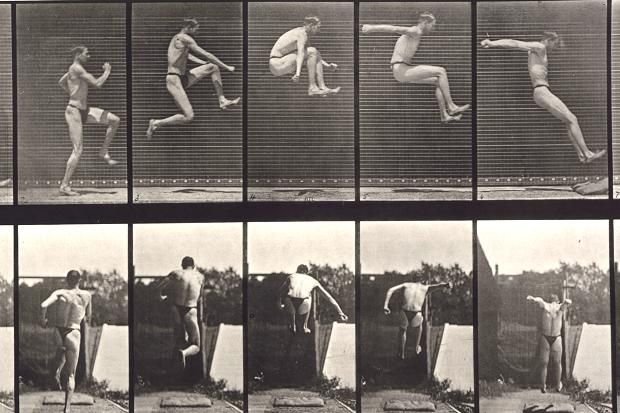
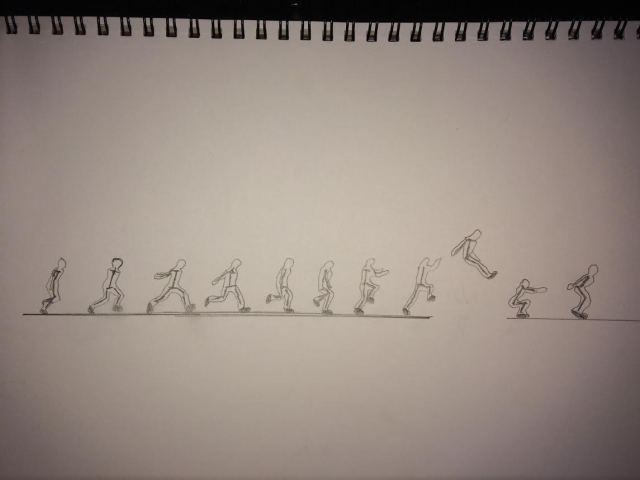
PRODUCTION/POLISHING
I then began the animation process by blocking my characters movements through the whole animation. Then creating its ups and downs , as well as its anticipations.Midway through this process though i ran into a timing issue. The animation went through a couple different iterations , due to lack of time and frame numbers. so i settled for and idea that i thought was fitting. But I didn’t have the necessary amount of frames needed to complete the project after the character makes the jump. So the idea was to add on a extra 50 Frames of my character landing , turning around and looking at the gap that he had just jumped. In the end i was happy that i did this, cause it gave a little more personality to the character and the scene.
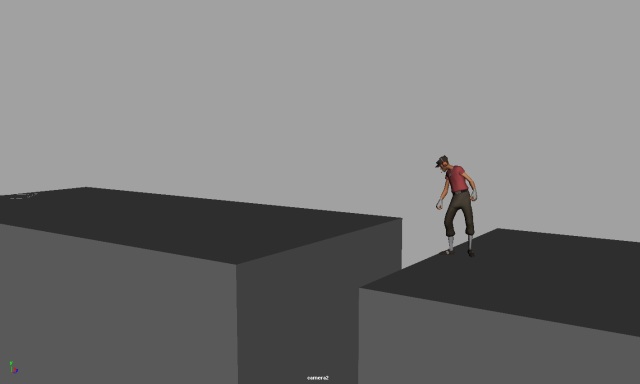
All in all this assessment was a little difficult to perfect, but given the time we had , Im happy with my efforts and look forward to future animation projects.
Pre Production/Planning
I began this assessment by deciding on a walk cycle that would challenge me and could be completed within the recommended time and frame number. The walk cycle i decided on was a sneak cycle.I started out by sketching my reference as well as researching videos and images to help with my process. Below is a reference sketch as well as a video that i continually looked at through my animation process.
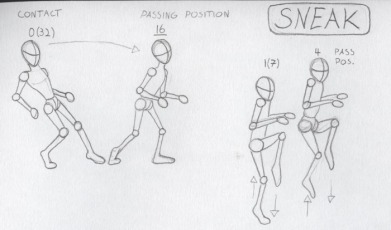
Blocking/Animation
I then headed into Maya and got to work on my blocking for my walk cycle. This wasn’t to hard of a task to complete, due to the great reference i had at my disposal and a well rigged character. The hard task was creating my first passing animation, i had some trouble at first making my character move forward without sliding especially in the ankle and toes. A lot of time was spent in the graph editor pulling and pushing keys trying to make it perfect, and with time i got there in the end. I then focused my attention to the upper body , working with the shoulders, elbows , wrists and clavicles and making it match with the flow of the leg movements. This was a important step because we needed to cycle our animation to do a continues walk. So the last key frames of the arms and legs needed to be the same as my first. i did this by copying the stats of my first frames in the graph editor and pasting them in the last frame of the same control. This in the end made my animation go through a continues walk with no problems. All in all i feel this assessment was a good challenge for me. It gave me a a greater understanding of human body movement and flow to incorporate into my animation as well as future assignments.
PRE PRODUCTION/PLANNING
I started out by deciding on a Story idea that could be easily told within the recommended time and frame number. A story that didn’t try to hard and got the point across to the viewer. I then had to choose one of three different complex options given to me for this assessment. At first I decided a single bouncing ball would work for my story . But i quickly found out that it wouldn’t meet the criteria of this assessment . So instead i went with a Character with a movable tale , that would bounce its way through a small obstacle course . Next i took my idea and sketched it out as best as i could, to give myself the easiest reference possible, and take it over to Maya and create it. This consisted of not only showing off the obstacle course that i had in mind , but to also visualize what my character would be doing within the course , which showed off a small sketch of my character bouncing frame by frame and showing off the necessary bounces. Research was needed for my characters sketching, below are some video references that i found , as well as sketches of my own and from other artists showing off the step by step nature of bounces.
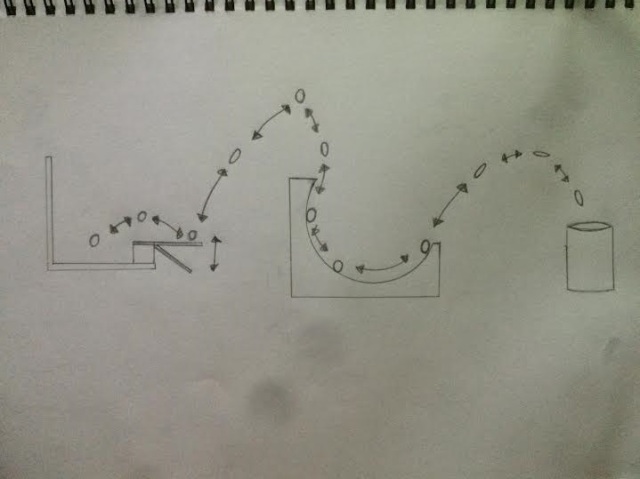
Design layout for my animation
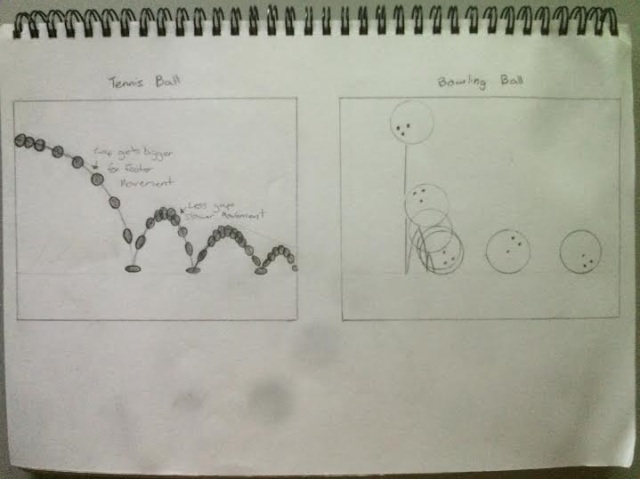
Recreation of bounces , using different types of balls

EDUARD RUESGA-Animation reference

DESIGN/ANIMATION
I then headed into Maya and got to work on my obstacle design. Much like the story , the obstacle stayed simple , only 4 parts were made for our character to interact with. Enough for the viewers to see and take in , and enough to show off our characters animations nicely. I then began the animation process by blocking my characters movements through the whole animation. Then creating its ups and downs , as well as its anticipations. This step wasn’t to troublesome , i had my idea laid out , and executed it nicely. The movement however was stiff and i had some trouble with making the character come to life through the 12 principles of animation, Squash&stretch, Timing etc etc. This came down to polishing.
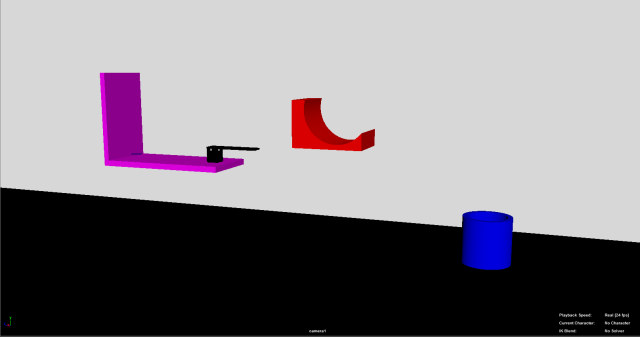
POLISHING/LEARNING PROCESS
Polishing was the most tedious part of this animation. Many hours were spent in the graph editor pulling and pushing keys trying to make it perfect. The tail was the most difficult part of this animation due to its four control rigs. Jumping from control to control made this a little more of a hassle then it could have been if it were just the ball itself. A lot of times i would find myself keying frames on the wrong control, or trying to fix animation issues on the wrong axis, and getting nowhere with time passing. But during these frustrating periods i learnt something new every time , and have not repeated mistakes since. Animation is definitely something that with enough time , i will get the hang of , especially as more complex tasks come my way. But this process of starting something of my own and finishing it has exited me to push my ideas further and challenge myself to do better.
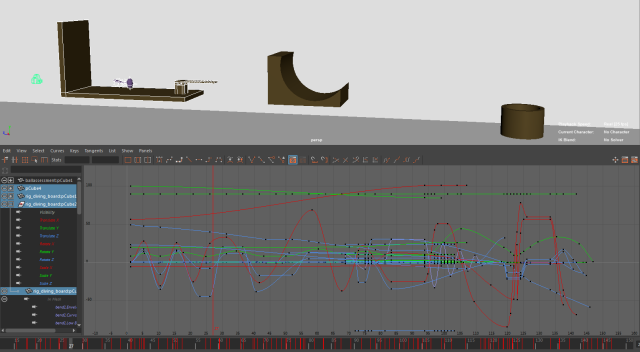
I.S
Medium: A4 visual diary using HB and 4B pencils for shading and defining. Derwent Artist pencils in Deen Vermillon (muscle and blood zone), and Golden Brown (skeleton). Artist Color pencil # 3 ruzicasta (pale pink) used for skin tone
The homework brief was to show off the interconnections of the bone and muscle of the human body. Getting the proportions of the human body played a big part in these drawings, and matching up each bone and muscle to its designated place. One thing that pops with these drawings is the colour. Instead of shading the parts I wanted to show off, I used colour instead. Brown was used to match the bone, pink to match the skin and red to represent muscle and blood zones. The picture in the top right is a perfect example. I used repetitive curved lines to represent striation of the muscle tendons in the chest, ribs, neck and abdominal region and solid colours to represent the mechanical part of bones and skin. This type of work is something I would like to develop further, not only because it gives me a greater understanding of the human body, but it also helps in getting the human proportions for life drawings, quick sketches and 3D modelling perfected and realistic.
I.S
Medium: Cretacolor white pencil on A3 black cardboard.
This drawing is a personal favourite of mine for many reasons. I liked the change of shading techniques from black to white, especially with the object we were given. I’ve always been intrigued with skulls, whether it is human or animal. I embrace the darker side to their look and feel. It was a struggle to get the proportions of the skulls head to match each side due to the unevenness of the skull itself but in the end turned out well. The most successful part of this drawing I believe is the shading. I feel the white shading comes across as light hitting a dark object, and the black paper complements it, more than white paper with black shading would have.
I.S
PORTFOLIO OF VISUAL ART EXERCISES, February 2015 – May 2015
Medium used: HB pencil in an A4 visual diary.
The first of three drawings chosen was drawn on the first day of the TAFE semester for a field trip to Cockatoo Island. The objective was to draw an object or architectural structural with as much detail as possible. Right by the water in between other buildings, was a run-down factory building that I chose. Using a ruler I attempted to get the proportions and flow of the building and to define the sharp edges and lines of the building’s windowsills, pipes, gutters and rooftops. There was too much dependence on having the safety of the ruler for ‘straight’ walls, which doesn’t age or authenticity to the building. The drawing sells itself short with no toning to give perception and a sense of depth.
If I were given the chance to do it again I would like to include a backdrop of the water, the buildings on each side and more of the nature surrounding it. Nonetheless, I look back at this drawing and see a ‘newbie’ trying, and realising how far I have come in such a small amount of time. Hopefully, I’ll get to return to Cockatoo Island and have another crack at it.
I.S
The main definition for genre as defined by the online dictionary,merriam-webster.com is
“a category of artistic, musical, or literary composition characterised by a particular style, form, or content.” (1)
Genre, a word originating from France, meaning “kind” or “sort” can be written, spoken, audio or visual, based on a set of stylistic criteria. Over time, as styles and conventions change, new genres are invented and older ones discontinued.
There are almost a dozen main genres, and within these, there are sub-genres, which can describe practically any film ever made.
It was not until the 1970s that film began to be analysed through genres. All films have at least one major genre, but there can be more with some films having up to four sub-genres that can also be used. (ref: filmsite.org)
The Auteur System can be contrasted to the genre system, in which films are rated on the basis of the expression of one person, usually the director, because his/her indelible style, authoring vision or ‘signature’ dictates the personality, look, and feel of the film. Certain directors and actors are known for certain types of films, for example, Woody Allen and comedy, Alfred Hitchcock for suspense and thrillers and John Ford and John Wayne with westerns. (2)
Biographies deal with the life of an individual and have the power to tell the stories of the everyday men and women of this world. A well made biography can be motivational, heartbreaking, humourous, and even frightening.
Most biographies will be fictionalised versions, with “Based On A True Story” being shown before the movie commences.
Bronson, starring Tom Hardy, is a film about Britain’s most violent prisoner, Michael Peterson. In 1974 Peterson was sentenced to seven years in prison for robbing a post office, but ends up spending over 30 years in more than 100 different prisons. Although, he is a notorious criminal, the visual styling of the movie portrays the three decades through fashion and environment. As he creates his alter ego of Charles Bronson, his dialogue portrays time and place. We know Bronson is a violent, psychotic criminal, but the movie keeps our total revulsion suspended with a comedic narrative throughout. (3)
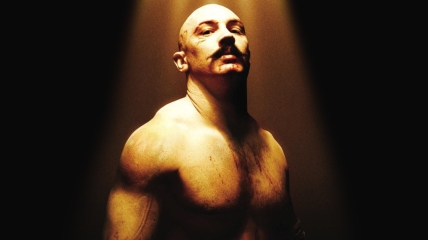
Bronson. (2008).Directed by Nicolas Winding Refn. Photo credit- https://fanart.tv/movie/18533/bronson/
If the sub-genre of Bronson were changed from bio/comedic to only drama, the audience would have no room for empathy for Michael Peterson. Through the direction of Director, Tom Hardy’s Peterson has snuck in to our subconscious us as someone we mistakenly believe we could actually like.
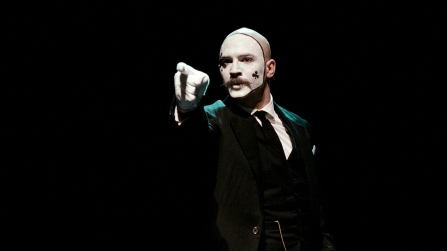
Bronson.(2008).Directed by Nicolas Winding Refn. Photocredit-http://www.headstartonhealthyliving.com/2015/03/solitary-fitness-charles-bronson/
Fictionalised or not, a biography, is still the story of an individual we do not know and would never know if not through film; whether it be Jobs, showing us the legacy of Steve Jobs and Apple; or Bronson, a hardened criminal. Both can make you come away with different emotions, outlooks on the world and the people who live in it.
I.S
READINGS-
(1) http://www.merriam-webster.com/dictionary/genre
(2) http://www.filmsite.org/genres.html
(3) http://listverse.com/2014/06/16/10-truly-bizarre-facts-about-englands-most-insane-prisoner/
Mise-en-scène is French for placing on stage or “placing on the screen” for film purposes. (3)
Mise-en-scène refers to everything that appears before the camera and its arrangement. Along with the cinematography and editing of a film, it influences the believability for the viewer.
Various elements of design generate a sense of time and space, as well as setting a mood, and may suggest a character’s state of mind.
The Black Swan, a movie directed by Darren Aronofsky, gives life to light and darkness and tells a beautiful, dark, twisted story, through its set design, lighting and colour palettes, costumes, as well as the acting, and even composition., (as discussed in an earlier post April 28, 2015)
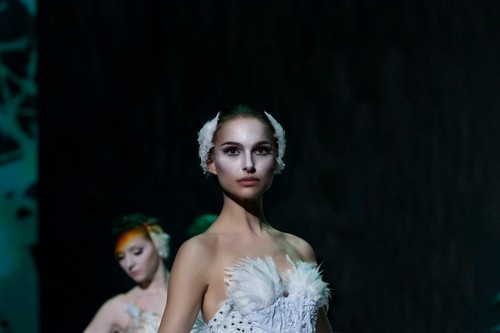
The Black Swan. (2010). Directed by Darren Aronofsky. Photo credit- http://www.fanpop.com/clubs/natalie-portman/images/27525764/title/new-black-swan-stills-photo
Success with the various elements in a movie is only possible through a collaborative partnership with the director who has the vision. From the craftsmen building sets, to the cinematographer who chooses the lighting, the mise-en-scene is the result of many contributors.
One of the most important collaborators with the director is the production designer. Together they perfect all the aspects of the mise-en-scene, long before the actual filming even begins. The production designer is generally responsible for the look of the movie and leads various departments. Within the production environment, the director is more specific with his requests and orders whether to the prop master, the set designer, the make-up artists or the actors. All influence the mise-en-scene.
Set design
An important element of “putting in the scene” is the setting, and the objects (props) visible in a scene. Set design can be used to amplify character emotion or the dominant mood, which has physical, social, psychological, emotional, economic and cultural significance in film. (3)
The shot below shows the precision of choreographed rehearsal, and illustrates the movie’s theme of light versus darkness.

The Black Swan. (2010). Directed by Darren Aronofsky. Photo credit – http://www.fanpop.com/clubs/black-swan/images/19071961/title/black-swan-stills-photo
Lighting
Unarguably, lighting is an element with great power. The intensity, direction, and quality of lighting can influence the audience’s understanding of characters, actions, themes and mood. Light (and shade) can emphasize texture, shape, distance, mood, time of day or night, season, glamour; it affects the way colours are rendered, both in terms of hue and depth, and can focus attention on particular elements of the composition. The Black Swan has all of these; not only does the lighting grasp the two identities Natalie Portman portrays, it also showcases the authenticity of the ballet and the story is told through it. (1)
Acting
Acting has become one of the most important elements of film. An actor’s performance can make or break a movie regardless of how engaging the story is or how well the editing was done. It is the actor’s duty to bring their character to life within the framework of the story. Their emotional input dictates how strongly the audience feels about the film. An actor must be completely aware of their character and be ready to portray their emotions and actions as if they were their own. The actor is the basic element of 99% of films which guides the audience to empathy and reality for the movie. (2)
I.S
Readings –
(1) http://www.slideshare.net/sarahlou79/mise-en-scene-14239171
(2) http://collegefilmandmediastudies.com/mise-en-scene-2/
(3) http://www.elementsofcinema.com/directing/mise-en-scene-in-films/
Composition is the placement or arrangement of visual elements or ingredients in a work of art, as distinct from the subject of a work.
There are a number of established composition principles, which can be applied in almost any situation to enhance the impact of a scene. These principles will help you take more compelling photographs, tell a more in depth story, or just make whatever you are creating more visually pleasing lending the audience a helping hand.
I will list a few of these principles and once you are familiar with these principles, you’ll be surprised at just how universal most of them are. You’ll spot them everywhere, and you’ll find it easy to see why some composition works, while others feel like simple basic shots.
One of these principles is THE RULE OF THIRDS. Imagine that your image is divided into 9 equal segments by 2 vertical and 2 horizontal lines. The Rule of Thirds requires you to position the most important elements in your scene along these lines, or at the points where they intersect. When you look at a photo the eye is naturally drawn along lines. By thinking about how you place lines in your composition, you can affect the way you view the image, pulling you into the picture towards the subject or on a journey through the scene. Doing so will add balance and interest to your shot. A great example to show balance and symmetrical composition, as well as other principles discussed here, are films by Wes Anderson.
This photo showcases our characters, the setting and the balance of the story it is trying to tell.
Another principle of composition is Centre of Interest. This is the area that first attracts attention and the importance of a scene in composition, either through more colour or the placement.
It is important to balance the “weight” of your story by including other objects of lesser importance to fill the space. In the image below, the focus is purely drawn to the man in the purple jacket, but there are enough objects and signs to give us insight to what he does, and his character’s plot in the movie.
Another principle is Viewpoint. Before shooting your subject, take time to think about where you will shoot it. The viewpoint has a massive impact on the composition of the shot, and as a result it can greatly affect the message that the shot conveys. Rather than just shooting from eye level, consider all angles.
Whatever medium you choose it is two-dimensional and the composition must be chosen carefully to convey the sense of depth that was present in the actual scenario.
Composition is what gets the message across to the audience. It is up to the creator whether he chooses to do this through objects, characters, colours, or viewpoints or a combination of some or all of these. By using the principles listed here, the creator guides his audience to his vision.
I.S
Readings
http://en.wikipedia.org/wiki/Composition_%28visual_arts%29
http://www.photographymad.com/pages/view/10-top-photography-composition-rules